NumPy中使用arange创建列向量的详细指南
参考:
NumPy是Python中用于科学计算的核心库,它提供了强大的多维数组对象和用于处理这些数组的工具。在NumPy中,arange函数是一个非常有用的工具,可以用来创建等差数列。而列向量是线性代数中的基本概念,在数据分析和机器学习中经常使用。本文将详细介绍如何使用NumPy的arange函数创建列向量,以及相关的操作和应用。
1. NumPy简介
NumPy(Numerical Python的缩写)是Python科学计算的基础库。它提供了一个强大的N维数组对象,以及用于对这些数组进行操作的各种工具。NumPy的核心是ndarray对象,它是一个多维数组,可以高效地存储和操作大型数据集。
在开始之前,我们需要导入NumPy库:
import numpy as np
print("Welcome to numpyarray.com")
Output:

这个简单的代码片段导入了NumPy库,并将其别名设置为np,这是一种常见的约定。
2. arange函数详解
arange函数是NumPy中用于创建等差数列的函数。它类似于Python内置的range函数,但返回的是NumPy数组而不是列表。
2.1 基本用法
arange函数的基本语法如下:
np.arange([start,] stop[, step,], dtype=None)
start:序列的起始值,默认为0stop:序列的结束值(不包含)step:两个相邻值之间的步长,默认为1dtype:数组的数据类型
让我们看一个简单的例子:
import numpy as np
# 创建一个从0到9的数组
arr = np.arange(10)
print("numpyarray.com example:", arr)
Output:

这个例子创建了一个包含0到9的数组。
2.2 指定起始值和步长
我们可以指定起始值和步长来创建更复杂的序列:
import numpy as np
# 创建一个从5到50,步长为5的数组
arr = np.arange(5, 51, 5)
print("numpyarray.com example:", arr)
Output:

这个例子创建了一个从5开始,到50结束(不包含),步长为5的数组。
2.3 使用浮点数
arange函数也可以使用浮点数:
import numpy as np
# 创建一个从0到1,步长为0.1的浮点数数组
arr = np.arange(0, 1.1, 0.1)
print("numpyarray.com example:", arr)
Output:

这个例子创建了一个从0到1(包含1),步长为0.1的浮点数数组。
3. 列向量的概念
在线性代数中,列向量是一种特殊的矩阵,它只有一列但可以有多行。在NumPy中,我们可以使用二维数组来表示列向量。
3.1 创建列向量
使用arange函数创建列向量的关键是要将结果重塑(reshape)为一个n行1列的数组。这可以通过reshape函数实现:
import numpy as np
# 创建一个5x1的列向量
column_vector = np.arange(5).reshape(-1, 1)
print("numpyarray.com example:")
print(column_vector)
Output:
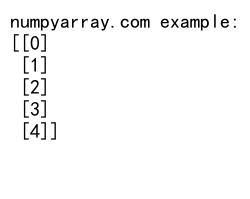
在这个例子中,我们首先创建了一个包含0到4的一维数组,然后使用reshape(-1, 1)将其转换为一个5行1列的二维数组,即列向量。
3.2 列向量的转置
列向量的转置是行向量。我们可以使用T属性来实现转置:
import numpy as np
# 创建一个列向量并转置
column_vector = np.arange(5).reshape(-1, 1)
row_vector = column_vector.T
print("numpyarray.com example:")
print("Column vector:")
print(column_vector)
print("Row vector:")
print(row_vector)
Output:
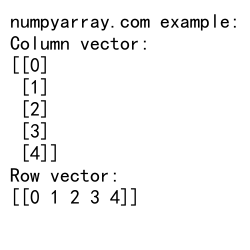
这个例子展示了如何创建一个列向量,并将其转置为行向量。
4. 使用arange创建特殊的列向量
arange函数的灵活性使我们能够创建各种特殊的列向量。
4.1 创建等差列向量
我们可以创建一个等差数列的列向量:
import numpy as np
# 创建一个从1到10,步长为2的列向量
column_vector = np.arange(1, 11, 2).reshape(-1, 1)
print("numpyarray.com example:")
print(column_vector)
Output:
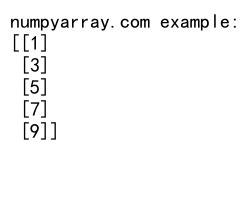
这个例子创建了一个包含1, 3, 5, 7, 9的列向量。
4.2 创建倒序列向量
我们可以使用负步长来创建倒序的列向量:
import numpy as np
# 创建一个从10到1,步长为-1的列向量
column_vector = np.arange(10, 0, -1).reshape(-1, 1)
print("numpyarray.com example:")
print(column_vector)
Output:
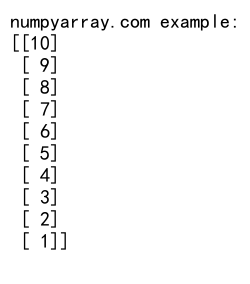
这个例子创建了一个从10倒数到1的列向量。
4.3 创建特定范围的列向量
我们可以创建一个特定范围内的列向量:
import numpy as np
# 创建一个从-5到5的列向量
column_vector = np.arange(-5, 6).reshape(-1, 1)
print("numpyarray.com example:")
print(column_vector)
Output:
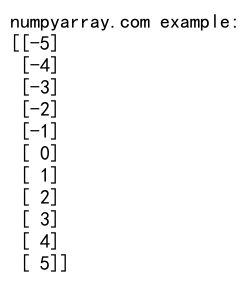
这个例子创建了一个包含-5到5的列向量。
5. 列向量的运算
列向量支持各种数学运算,这些运算通常是按元素进行的。
5.1 标量运算
我们可以对列向量进行标量运算:
import numpy as np
# 创建一个列向量并进行标量运算
column_vector = np.arange(1, 6).reshape(-1, 1)
result = column_vector * 2
print("numpyarray.com example:")
print("Original vector:")
print(column_vector)
print("After multiplication:")
print(result)
Output:
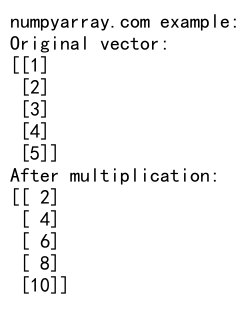
这个例子展示了如何将列向量中的每个元素乘以2。
5.2 向量加法
我们可以对两个相同形状的列向量进行加法运算:
import numpy as np
# 创建两个列向量并进行加法运算
vector1 = np.arange(1, 6).reshape(-1, 1)
vector2 = np.arange(6, 11).reshape(-1, 1)
result = vector1 + vector2
print("numpyarray.com example:")
print("Vector 1:")
print(vector1)
print("Vector 2:")
print(vector2)
print("Sum:")
print(result)
Output:
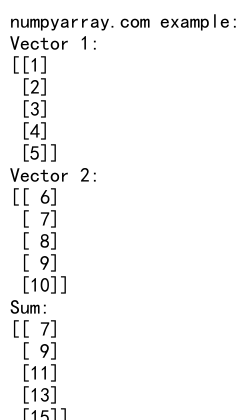
这个例子展示了如何对两个列向量进行元素级的加法运算。
5.3 点积运算
我们可以计算列向量与行向量的点积:
import numpy as np
# 计算列向量和行向量的点积
column_vector = np.arange(1, 6).reshape(-1, 1)
row_vector = np.arange(1, 6).reshape(1, -1)
dot_product = np.dot(column_vector.T, column_vector)
print("numpyarray.com example:")
print("Column vector:")
print(column_vector)
print("Row vector:")
print(row_vector)
print("Dot product:")
print(dot_product)
Output:
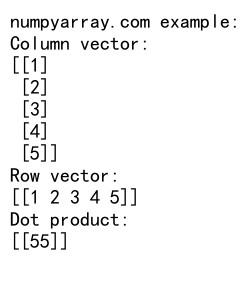
这个例子展示了如何计算列向量与其转置(行向量)的点积。
6. 列向量的应用
列向量在许多科学计算和数据分析任务中都有重要应用。
6.1 线性回归
在线性回归中,我们经常需要处理列向量形式的特征和目标变量:
import numpy as np
# 简单的线性回归示例
X = np.arange(1, 6).reshape(-1, 1) # 特征
y = np.array([2, 4, 5, 4, 5]).reshape(-1, 1) # 目标变量
# 计算回归系数
beta = np.linalg.inv(X.T.dot(X)).dot(X.T).dot(y)
print("numpyarray.com example:")
print("Feature vector X:")
print(X)
print("Target vector y:")
print(y)
print("Regression coefficient:")
print(beta)
Output:
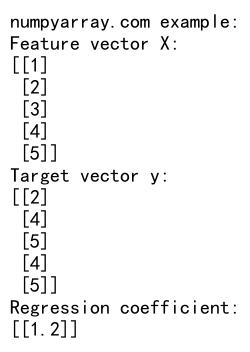
这个例子展示了如何使用列向量进行简单的线性回归计算。
6.2 特征缩放
在机器学习中,我们经常需要对特征进行缩放。列向量形式的数据很容易进行这种操作:
import numpy as np
# 特征缩放示例
X = np.arange(1, 11).reshape(-1, 1)
X_scaled = (X - X.mean()) / X.std()
print("numpyarray.com example:")
print("Original vector:")
print(X)
print("Scaled vector:")
print(X_scaled)
Output:
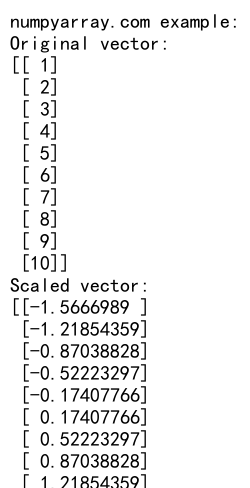
这个例子展示了如何对列向量进行标准化处理。
6.3 主成分分析(PCA)
在主成分分析中,我们需要处理列向量形式的数据:
import numpy as np
# 简化的PCA示例
X = np.array([[1, 2, 3], [4, 5, 6], [7, 8, 9]]).T # 每列是一个样本
X_centered = X - np.mean(X, axis=1).reshape(-1, 1)
cov_matrix = np.cov(X_centered)
eigenvalues, eigenvectors = np.linalg.eig(cov_matrix)
print("numpyarray.com example:")
print("Original data:")
print(X)
print("Centered data:")
print(X_centered)
print("Covariance matrix:")
print(cov_matrix)
print("Eigenvalues:")
print(eigenvalues)
print("Eigenvectors:")
print(eigenvectors)
Output:
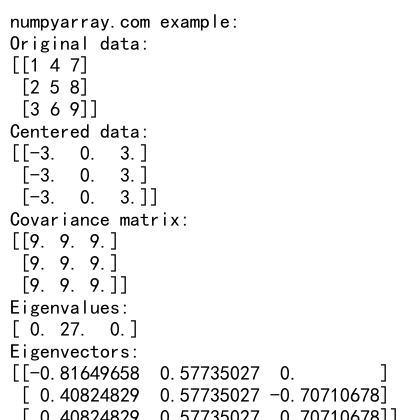
这个例子展示了如何使用列向量形式的数据进行简化的主成分分析。
7. 高级技巧
在使用arange创建列向量时,还有一些高级技巧可以使用。
7.1 使用linspace替代arange
有时候,np.linspace函数可能比arange更适合创建列向量,特别是当我们想要指定元素数量而不是步长时:
import numpy as np
# 使用linspace创建列向量
column_vector = np.linspace(0, 1, 5).reshape(-1, 1)
print("numpyarray.com example:")
print(column_vector)
Output:
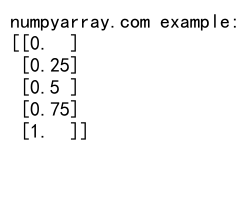
这个例子创建了一个包含5个等间隔元素的列向量,范围从0到1。
7.2 创建周期性列向量
我们可以结合arange和三角函数来创建周期性的列向量:
import numpy as np
# 创建周期性列向量
x = np.arange(0, 2*np.pi, 0.1).reshape(-1, 1)
y = np.sin(x)
print("numpyarray.com example:")
print("x values:")
print(x[:5]) # 只打印前5个值
print("sin(x) values:")
print(y[:5]) # 只打印前5个值
Output:
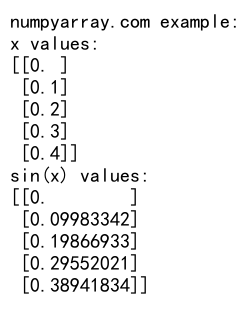
这个例子创建了一个正弦波的列向量。
7.3 使用广播机制
NumPy的广播机制允许我们对不同形状的数组进行操作。这在处理列向量时特别有用:
import numpy as np
# 使用广播机制
column_vector = np.arange(1, 6).reshape(-1, 1)
row_vector = np.array([1, 2, 3])
result = column_vector + row_vector
print("numpyarray.com example:")
print("Column vector:")
print(column_vector)
print("Row vector:")
print(row_vector)
print("Result:")
print(result)
Output:
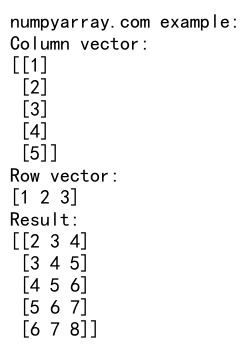
这个例子展示了如何使用广播机制将列向量与行向量相加。
8. 性能考虑
在使用arange创建列向量时,我们还需要考虑性能问题。
8.1 预分配内存
对于大型数组,预先分配内存可以提高性能:
import numpy as np
# 预分配内存
n = 1000000
column_vector = np.empty((n, 1))
column_vector[:, 0] = np.arange(n)
print("numpyarray.com example:")
print("Shape of the vector:", column_vector.shape)
print("First 5 elements:")
print(column_vector[:5])
Output:
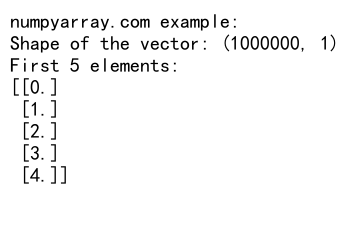
这个例子展示了如何预分配内存来创建一个大型列向量。
8.2 使用视图而不是副本
当可能的时候,使用视图而不是创建数组的副本可以提高性能:
import numpy as np
# 使用视图
original = np.arange(10)
column_vector = original.reshape(-1, 1)
print("numpyarray.com example:")
print("Original array:")
print(original)
print("Column vector (view):")
print(column_vector)
print("Is column_vector a view of original?", column_vector.base is original)
Output:
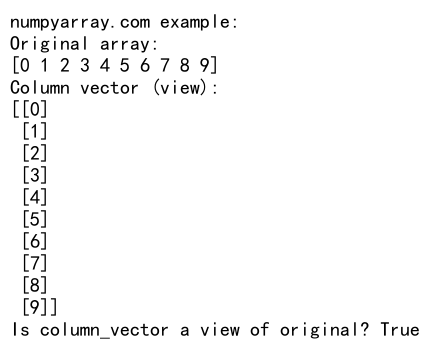
这个例子展示了如何创建原始数组的视图作为列向量,而不是创建一个新的数组。
9. 常见错误和注意事项
在使用arange创建列向量时,有一些常见的错误和注意事项需要避免。
9.1 维度错误
一个常见的错误是忘记使用reshape函数将一维数组转换为二维列向量:
import numpy as np
# 错误示例
incorrect_vector = np.arange(5)
# 正确示例
correct_vector = np.arange(5).reshape(-1, 1)
print("numpyarray.com example:")
print("Incorrect vector shape:", incorrect_vector.shape)
print("Correct vector shape:", correct_vector.shape)
Output:
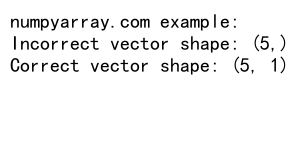
这个例子展示了正确和错误创建列向量的方法。
9.2 浮点精度问题
使用arange创建浮点数列向量时,可能会遇到精度问题:
import numpy as np
# 浮点精度问题示例
vector = np.arange(0, 1, 0.1)
print("numpyarray.com example:")
print("Vector length:", len(vector))
print("Last element:", vector[-1])
Output:
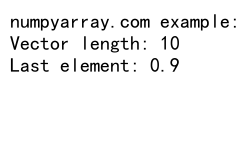
在这个例子中,由于浮点数精度的限制,最后一个元素可能不精确地等于1。
9.3 步长为零
使用步长为零会导致错误:
import numpy as np
try:
vector = np.arange(0, 5, 0).reshape(-1, 1)
except ValueError as e:
print("numpyarray.com example:")
print("Error:", str(e))
这个例子展示了当步长为零时会抛出的错误。
10. 与其他NumPy函数的结合使用
arange函数可以与其他NumPy函数结合使用,以创建更复杂的列向量。
10.1 与数学函数结合
我们可以将arange与NumPy的数学函数结合使用:
import numpy as np
# 创建一个指数增长的列向量
x = np.arange(0, 5).reshape(-1, 1)
y = np.exp(x)
print("numpyarray.com example:")
print("x values:")
print(x)
print("exp(x) values:")
print(y)
Output:
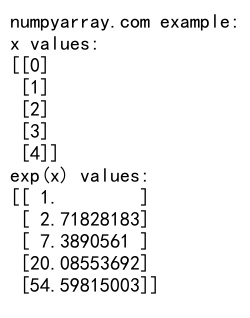
这个例子创建了一个指数增长的列向量。
10.2 与随机函数结合
我们可以将arange与NumPy的随机函数结合使用:
import numpy as np
# 创建一个带有随机噪声的列向量
x = np.arange(0, 10).reshape(-1, 1)
noise = np.random.normal(0, 0.1, x.shape)
y = x + noise
print("numpyarray.com example:")
print("Original vector:")
print(x)
print("Vector with noise:")
print(y)
Output:
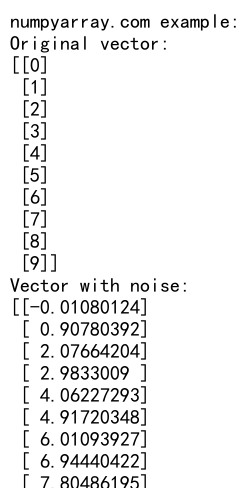
这个例子创建了一个带有随机高斯噪声的列向量。
10.3 与逻辑函数结合
我们可以将arange与NumPy的逻辑函数结合使用:
import numpy as np
# 创建一个布尔列向量
x = np.arange(10).reshape(-1, 1)
bool_vector = x % 2 == 0
print("numpyarray.com example:")
print("Original vector:")
print(x)
print("Boolean vector (even numbers):")
print(bool_vector)
Output:
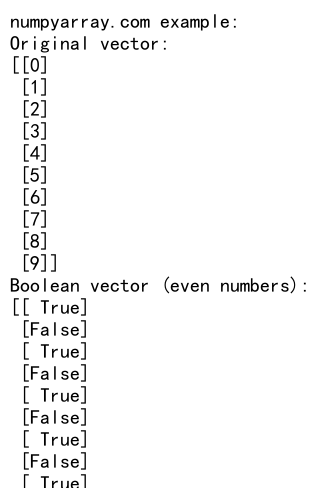
这个例子创建了一个布尔列向量,表示原始向量中的偶数。
11. 列向量在数据分析中的应用
列向量在数据分析中有广泛的应用,特别是在处理时间序列数据时。
11.1 时间序列分析
在时间序列分析中,我们经常需要创建一个时间索引:
import numpy as np
import pandas as pd
# 创建一个日期范围的列向量
dates = pd.date_range(start='2023-01-01', periods=5)
values = np.arange(1, 6).reshape(-1, 1)
df = pd.DataFrame(values, index=dates, columns=['Value'])
print("numpyarray.com example:")
print(df)
Output:
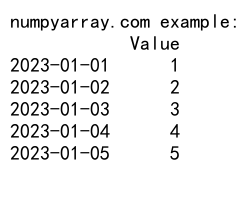
这个例子展示了如何创建一个带有日期索引的时间序列数据框。
11.2 特征工程
在特征工程中,我们可能需要创建多项式特征:
import numpy as np
from sklearn.preprocessing import PolynomialFeatures
# 创建多项式特征
X = np.arange(5).reshape(-1, 1)
poly = PolynomialFeatures(degree=2)
X_poly = poly.fit_transform(X)
print("numpyarray.com example:")
print("Original features:")
print(X)
print("Polynomial features:")
print(X_poly)
Output:
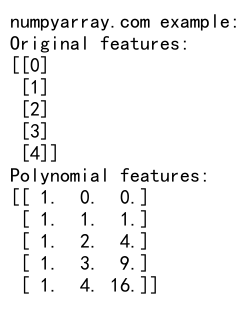
这个例子展示了如何使用列向量创建多项式特征。
11.3 数据可视化
列向量在数据可视化中也很有用:
import numpy as np
import matplotlib.pyplot as plt
# 创建一个简单的折线图
x = np.arange(0, 10, 0.1).reshape(-1, 1)
y = np.sin(x)
plt.figure(figsize=(10, 5))
plt.plot(x, y)
plt.title('Sine Wave')
plt.xlabel('x')
plt.ylabel('sin(x)')
plt.savefig('numpyarray_com_sine_wave.png')
plt.close()
print("numpyarray.com example: Sine wave plot saved as 'numpyarray_com_sine_wave.png'")
这个例子展示了如何使用列向量创建一个简单的正弦波图。
结论
NumPy的arange函数是一个强大的工具,可以用来创建各种类型的列向量。从简单的整数序列到复杂的数学函数,arange都能胜任。通过结合其他NumPy函数和技巧,我们可以创建出适用于各种数据分析和科学计算任务的列向量。
在使用arange创建列向量时,需要注意维度、精度和性能等问题。通过正确使用reshape函数、了解浮点数精度限制,以及采用适当的性能优化技巧,我们可以充分发挥arange函数的潜力。
列向量在线性代数、机器学习、数据分析和可视化等领域都有广泛的应用。掌握如何使用arange创建和操作列向量,将极大地提高我们处理数据的能力和效率。
无论是进行简单的数学运算,还是复杂的统计分析,列向量都是不可或缺的工具。通过本文的详细介绍和丰富的示例,读者应该能够熟练地使用NumPy的arange函数创建各种类型的列向量,并将其应用到实际的数据处理任务中。
 极客教程
极客教程